Method and device for analysis of the structure and the composition of cultured hedges such as for example rows of vines
a technology of structure and composition, applied in the field of method and device for analysis of the structure and composition of cultured hedges such as, can solve the problems of less widespread use of cutting bars by machines, serious damage to cutting tools, and inability to be done as quickly, so as to prevent damage to the cordon and undesired elimination of fruit, the effect of increasing the movement speed of the machin
- Summary
- Abstract
- Description
- Claims
- Application Information
AI Technical Summary
Benefits of technology
Problems solved by technology
Method used
Image
Examples
Embodiment Construction
[0066]Reference is made to the drawings to describe examples that are of interest, though in no way restrictive, for operating the process and embodiments of the device for analysis of the structure of fruit-bearing hedgerows according to the invention.
[0067]This device comprises an artificial vision system (FIG. 1) functioning by direct transmission and comprising, on the one hand, at least one emitter module EM comprising at least one, and preferably, many emitters of light beams E (E1, E2, E3 . . . ), and, on the other hand, at least one receiving module RM comprising at least one, and preferably, many receivers of light beams R (R1, R2, R3 . . . ). In an advantageous manner, this artificial vision system is comprised of infrared emitters and receivers, and more specifically, near-infrared emitters and receivers.
[0068]Preferably, installed in front of the operating head of the agricultural machine, i.e. the cutting head 1 for pre-pruning 2 (FIG. 2), for example, of the type descr...
PUM
| Property | Measurement | Unit |
|---|---|---|
| wavelength | aaaaa | aaaaa |
| wavelength | aaaaa | aaaaa |
| wavelength | aaaaa | aaaaa |
Abstract
Description
Claims
Application Information
 Login to View More
Login to View More - R&D
- Intellectual Property
- Life Sciences
- Materials
- Tech Scout
- Unparalleled Data Quality
- Higher Quality Content
- 60% Fewer Hallucinations
Browse by: Latest US Patents, China's latest patents, Technical Efficacy Thesaurus, Application Domain, Technology Topic, Popular Technical Reports.
© 2025 PatSnap. All rights reserved.Legal|Privacy policy|Modern Slavery Act Transparency Statement|Sitemap|About US| Contact US: help@patsnap.com



